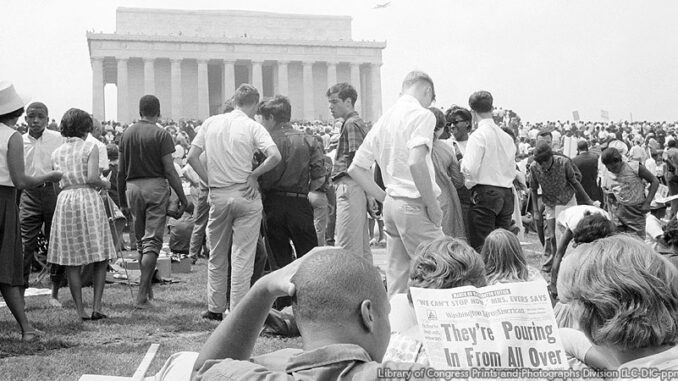
Commemorating the March
People from all over the world will descend upon our nation’s capital between August 21 and August 28 to remember and celebrate the 50th anniversary of the 1963March on Washington. Participants can follow the original march route to the Lincoln Memorial, attend worship services, festivals, conference sessions, panel discussion, a gospel brunch, and participate in a bell-ringing ceremony. The festivities conclude with Let Freedom Ring: a Commemorative/Call to Action Closing Ceremony, featuring speeches by Bill Clinton, Jimmy Carter and President Obama.
In addition to the events happening around town, several museums are featuring exhibitions with themes based around the March on Washington. At the National Museum of American History there is “Changing America: the Emancipation Proclamation, 1863 and the March on Washington.” This retrospective chronicles 50 years of struggle. “A Day Like No Other” is an exhibition of photography on display at the Library of Congress. The Newseum opened a new permanent exhibit called “Make Some Noise: Students and the Civil Rights Movement.” “American People, Black Light: Faith Ringgold’s Paintings of the 1960s” will be on display at the National Museum of Women, and the National Portrait Gallery will present “One Life: Martin Luther King, Jr.”
Dig Deeper–Look up a schedule for the 50th anniversary celebration like this one. Pick one event that interests you. Pretend that you are a reporter covering the story and write 100 words about your experience.
A Dream Realized?

Hundreds of thousands of people participated in the March on Washington. They filled the Mall between the Lincoln Memorial and the Washington Monument.
The organizers of the March on Washington had a straightforward, if not easy, goal–one standard of justice, decency and equal opportunities for all people.
The fact that we have an African-American president, something that seemed truly unimaginable in 1963, is evidence for many that we’ve come a long way toward closing the gap of racial inequality. Others point to the controversial Trayvon Martin verdict and stricter voter-ID requirements as evidence that we still have a long way to go.
How do we measure the impact of Dr. King’s message? Today more blacks are graduating high school, attending college and owning homes than ever before, and poverty rates have gone down. African Americans, as well as other minorities are better represented in Congress than they were fifty years ago as well. On the other hand, prison rates among African American (especially men) have gone up, and their life expectancy is less than then Caucasians.
How to interpret these statements is a challenge for all citizens of this country. It is also part of our responsibility–and the responsibility of our elected officials–to keep the goal of equality in mind when voting, debating legislation, giving political and charitable donations, and interacting with others in our daily lives. Dr. King’s dream was a grand, challenging one. But it is up to us to make it real.
What Do You Think? By 2033, the majority of children under the age of 18 will be minorities. What impact do you believe this will have on our culture at large?
Landmark Legislation
The March on Washington is considered one of the highlights of the civil right movement. It helped pass two very important pieces of legislation. The Civil Rights Act of 1964 and the Voting Rights Act of 1965. Before this, African Americans often experienced separate (and often inferior) public services in schools, public transportation, restrooms, and restaurants. The 1954 Brown vs. Board of Education Supreme Court ruling began challenging this segregation for public schools. But a history and a culture of discrimination continued to exist long after 1954.
President Kennedy made a Civil Rights Address that was broadcast over the radio and television on June 11, 1963, two months before the March on Washington. After Kennedy was assassinated in November of that year, President Lyndon Johnson made sure the momentum started by Kennedy and the March was not lost.
The Civil Rights Act of 1964 was signed into law. It became illegal to discriminate based on race, ethnicity, gender, or religious affiliation. It also ended racial segregation in schools. The Voting Rights Act of 1965 was passed because Congress decided that the Fifteenth Amendment, which prohibits the government (local, state and federal) from denying a U.S. citizen the right to vote based on race, was not keeping states from doing things like requiring a fees or literacy tests in order to vote.
Dig Deeper–There were many other pieces of legislation passed in the wake of the March on Washington (the Voting Rights Act of 1968 and the 1968 Fair Housing Act to name a few). Make a list of as many as you can find. What do they have in common? How do they differ?
She Also Had a Dream
Very often, great works of art are influenced by important art that came beforehand. When Dr. Martin Luther King, Jr. gave his address at the 1963 March on Washington, the “I Have a Dream” cadence was somewhat improvised . . . but it wasn’t entirely off-the-cuff. Singer Mahalia Jackson, who was part of the March’s festivities, had heard King speak in Detroit two months before. During that speech, he had used the phrase “I have a dream”.
King, however, had heard another speaker, Prathia Hall, use the phrase the year before at a service held at a church in Georgia that had been burned to the ground by the Ku Klux Klan. When Hall got up to pray, she entranced the crowd with a hypnotic repetition of the phrase, “I have a dream.” King had great respect and admiration for her, and credited her influence.
Hall grew up the daughter of a Baptist minister in Philadelphia, Pennsylvania. She dropped out of college to join the Freedom Fighters, and was active in other organization focused on civil rights. She eventually followed her father into ministry and became the first woman to become a member of the Baptist Minister’s Conference of Philadelphia.
